


Framed or unframed, desk size to sofa size, printed by us in Arizona and Alabama since 2007. Explore now.
Shorpy is funded by you. Patreon contributors get an ad-free experience.
Learn more.

- Baldwin 62303
- Baldwin VO-1000
- Cold
- No expense spared
- Tough Guys
- Lost in Toyland
- And without gloves
- If I were a blindfolded time traveler
- Smoke Consumer Also Cooks
- Oh that stove!
- Possibly still there?
- What?!?
- $100 Reward
- Freeze Frame
- Texas Flyer wanted
- Just a Year Too Soon
- WWII -- Replacing men with women at the railroad crossing.
- Yes, Icing
- You kids drive me nuts!
- NOT An Easy Job
- I wonder
- Just add window boxes
- Icing Platform?
- Indiana Harbor Belt abides
- Freezing haze
- Corrections (for those who care)
- C&NW at Nelson
- Fallen Flags
- A dangerous job made worse
- Water Stop
Print Emporium
Hop In: 1937
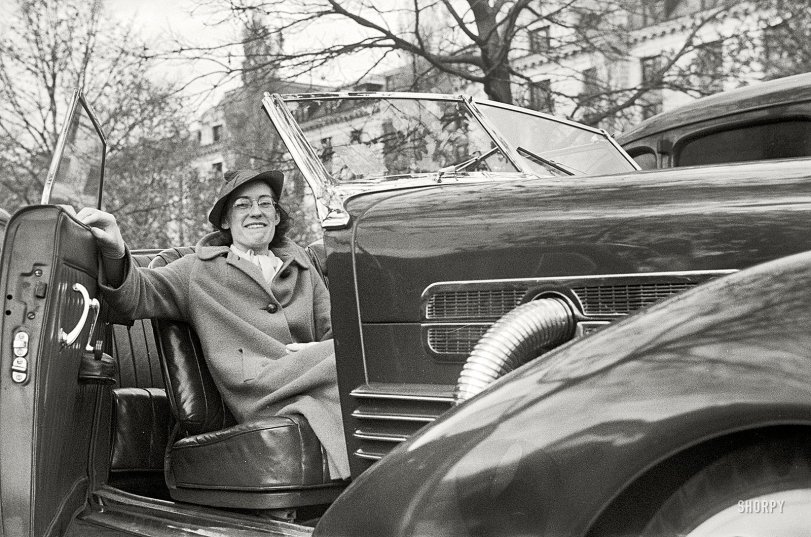
Uncaptioned photo from a batch of 35mm negatives taken by John Vachon in the fall of 1937 in Annapolis, Maryland, and Newport News, Virginia. The car, a Cord convertible, would be worth around a zillion bucks today. View full size.
Auburn-Cord-Duesenberg Festival
Born in Motown, having a father that loved autos and then living in South Bend, Indiana from 1970-79 afforded my family the opportunity to visit Auburn during the Labor Day weekend "Auburn-Cord-Duesenberg Festival" in its infancy in the early 70s when I was about 10 or 11.
My dad's territory (he was a salesman for Belknap Hardware, a Louisville-based hardware wholesaler) was northern Indiana and SW Michigan and had heard through the grapevine about a classic car festival and auction at Auburn High School. We were off!
The museum is a wonderful tribute to art deco architecture and for anyone passing through Fort Wayne or with an appreciation for the classics, this is a must see. Though I would highly recommend attending during the Labor Day weekend. Studebaker was but a distant memory for South Bend even in the 70s.
We moved back to Detroit in the 80s and visited Auburn during the festival a few times since. It has grown considerably in size and attendance and a few years ago went through tough times with the auctioneer being accused of not paying sellers after their vehicles sold.
Auburn is where dad taught his daughter true appreciation for--and identification of--the classics. My favorite is indeed the Auburn Boattail Speedster!
Invitation to the past
It's as if this lady is beckoning us to come back in time and take a ride in this classic car. The chrome is pristine, the paint glows. The leather is soft and supple. The finely tuned engine purrs with restrained power. Take a ride and relish an era before plastics and electronics rob us of the soul of the machine.
Stars with Cords
There's a much circulated Internet photo of the happily-married Hollywood stars Joan Blondell & Dick Powell in their Cord convertible, taken about 1937 looking both glamorous & prosperous. Also, cowboy star Tom Mix met his untimely demise speeding through Arizona while driving his Cord convertible in 1940, when an unsecured heavy metal suitcase slammed into the back of his head. TM's restored car survives and was recently featured in an Antique Automobile Club magazine article.
So he was an artist
RE: "Buehrig eventually ended up at Ford, where he had a hand in designing the lovely 56 Lincoln Mark II" -- interesting point I did not know. I liked that Lincoln, and only that Lincoln. It seemed rather out in left field compared to Ford's other production. His hand in it explains that anomaly.
Old Car Insurance
To chime in on this subject, most collectable and antique vehicles (25 yrs. old and older) are insured by companies that specialize in this coverage. They agree on a stated value, and limit annual mileage to 2500 miles (this may vary depending on the insurer). This coverage will not allow the vehicle to be a daily driver, just what would be considered normal driving to car shows, swap meets, cruise nights, and the occasional spin around town. Because of these restrictions, the cost of insurance is very reasonable. As OldFogie noted, driving one of these classics "every day" is a different story. You would have to find a mainstream company to agree to a stated value and then pay through the nose, I'm sure!
Insurance
Collector Car insurance is pretty reasonably priced (compared to the value of the vehicle). It's generally based upon very limited street usage, with severe limits to the number of miles that the car can be driven. Unfortunately, things like Cords tend to mostly be trailer queens these days, with the majority of their miles put on during tours before or after car shows. (Thus speaketh the car show judge)
Timeless beauty
The 810/812 series Cords replaced the disastrous L29s. Errett Lobban Cord wanted a car bearing his name. Front wheel drive. On the cheap. Thus, it was decided the straight eight Auburn motor would be used in order to save the R and D costs associated with a new engine. The result was that the normal front to rear sequence of engine, transmission and differential was simply reversed in the L29. From the front it became differential, transmission, and the very long straight eight. The car was engineered by the one and only Harry Miller, and design was under the supervision of Auburn chief designer Al Leamy. Industrial designer Brooks Stevens worked up a stunning one off L29. Functionally the cars were a disaster, as the long wheelbase put very little weight over the front drive wheels. Uphill movement, especially in the rain, became hazardous because there was so little traction. The wheels would slip, and frequently ignore any attempt at turning. The model lasted two years, I believe. By the time the beautiful Buehrig ‘coffin nose’ masterpiece came to market, engineered and designed to perfection, it was too late. The depression pretty much did the car and the Auburn, Cord Duesenberg Company in. I understand Cord was in England settled in for the long haul, as the Securities and Exchange folk wanted to talk with him. Buehrig eventually ended up at Ford, where he had a hand in designing the lovely 56 Lincoln Mark II, among other cars. It’s a rare ‘most beautiful cars ever’ list one will see that doesn’t include the Cord 810/812s. They’re timeless.
And blinking headlamps, too.
Aside from the front wheel drive, another innovation is the disappearing headlamps. Geo might have a point about insurance for collectors as good risks. I pay $56 a month, full coverage, for a fleet of vintage Jaguars and one vintage Cadillac (no accidents, ever). Most I know pay far more for a single car. But I'm betting insurance on a real classic *driven as a daily driver* would be considerably higher than for one infrequently driven (a point my insurance agent checks annually with odometer readings). Quotes for my insurance varied by a factor of 20.
A first and a last.
This car was noted for being an early front wheel drive vehicle but it was also one of the last cars to be designed entirely by one man. Gordon Buehrig was the designer's name. He was also responsible for Auburn's boat tail speedster and many other notable design concepts.
Insurance
OldFogie wonders below about insurance premiums. One of my colleagues restored Studebakers. I asked him about insurance, and he said it was quite reasonable. The impression I got is that insurance companies figure collectors/restorers are good risks.
Can any of you more knowledgeable guys/gals chime in on this?
Front Wheel Drive
One of the most important features of this car is the front wheel drive. It is one of the few front wheel drive American cars made before WWII that were produced in any appreciable quantity (1,146 in 1937).
The Cord 812s with superchargers are even rarer (less than 200 built over two years).
Cost in 1937 was $2,560. Prices today vary depending on condition, originality, presence of a supercharger, provenance, options, etc., but expect to pay $200,000 - $275,000 for a supercharged exampled in very good condition.
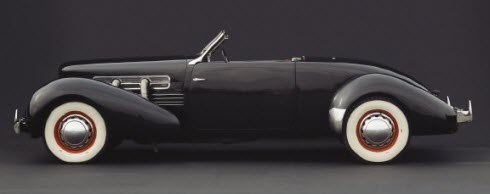
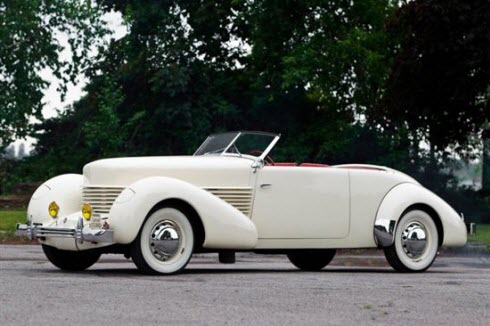
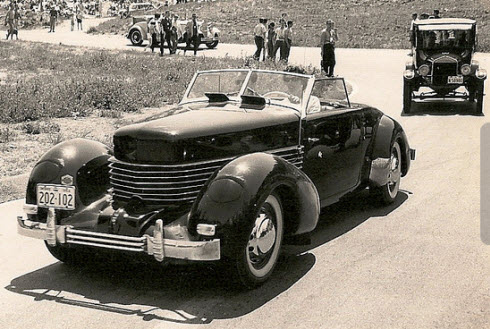
Tom Mix had one
A nice supercharged 37 went for 130k at last fall's auction in Hershey. I believe it was a former AACA winner from the 70's, but still a 90+ point car on the CCCA scale.
Tom Mix had one of these and it still exists and has been restored.
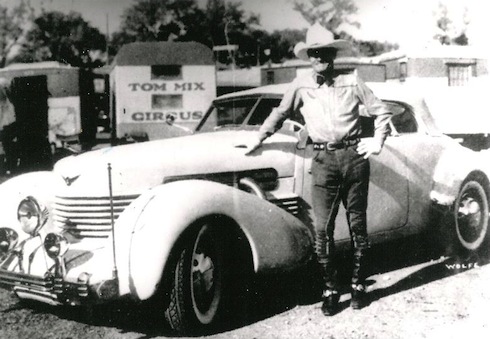
Thought balloon
"That's right, my car is better than yours."
$185k
There is a nicely restored '37 Cord Phaeton currently in Hemmings for $185k.
http://www.hemmings.com/classifieds/dealer/cord/810/1412757.html
Must be that "new math"
It seems that $75K only gets you the original steel body, with all mechanicals replaced with modern equipment. A complete original will go well into 7 figures. There's a nice original yellow '37 here in my hometown that I see at the post office or court house now and again, owned by a local retired grocer (who owns more than 60 cars of similar caliber).
Another pricey car I see frequently is a '37 Auburn boattail convertible used as a daily driver by a retired auto dealer. (I'd hate to see his insurance bill). Our smirking driver here is no more attractive than the grocer's daughter whom I dated in high school, with a face too high a price to pay daily for a chance to inherit even that collection.
Suped-up
Ah, the Cord convertible. In "Anybody Can Do Anything," a sequel to "The Egg and I," Betty MacDonald writes about the cream-colored Cord convertible her brother owned, and how the family would go for rides on weekends until they couldn't afford the gas. Then the Cord became part of an intricate series of trades that I think ended up with him acquiring a house.
I found this interesting, from Wikipedia:
Supercharging was made available on the 1937 812 model. Supercharged 812 models were distinguished from the normally aspirated 812s by the brilliant chrome-plated external exhaust pipes mounted on each side of the hood and grill. With supercharging, horsepower was raised to 170.
It was too late to save Cord, but the contraction "Suped" (referring its supercharged engine) lived on in American lexicon as the hot-rodding phrase "Suped-Up."
[To be taken with a grain of salt. The expression is "souped up" -- for which Webster's gives an entirely different derivation. - Dave]
























On Shorpy:
Today’s Top 5